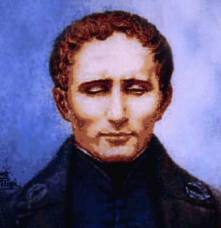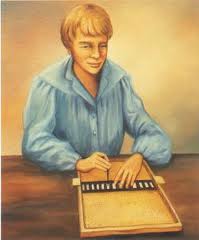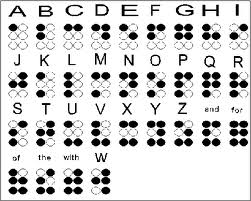Louis Braille found 63 different ways to represent a six-dot cell giving blind people the ability to read and write with ease and accuracy, something that had not been available to them before.

The story of braille ends with a French teenager called Louis Braille but it begins centuries before his birth with the founding of the first school for the blind.
It actually goes back to 1260 when Louis IX of France created the first royal institution for the sightless. He called it Quinze-Vingts (in English "Fifteen Score" or 300) and legend has it that this name referred to the 300 blind knights that lived there because they had had their eyes put out as punishment by the Saracens in a failed crusade.
This gruesome tale is, luckily, not true.
Whatever its origins the Quinze-Vingts did provide shelter and community for blind Parisians and went on doing so for the next 500 years. Fast forward to Place de la Concorde in 1771 and a young man called Valentin Haüy who is stood observing an crowd-pleasing act.
The act was part of the St. Ovid's fair and consisted of an ensemble from Quinze-Vingts doing a slapstick comedy act by attempting to play instruments.
They were variously kitted out in dunces caps and over-sized glasses, being mocked mercilessly by the crowd. Haüy couldn't bear the sight and from that day was determined to help the plight of the blind. With the help of some bright blind students Haüy set up a school for blind children that ran out of his home.
Soon he had 48 pupils, boys and girls, and was attracting sponsorship from the Academy of Music and royalty.
Some 20 years later in a small village called Coupvray outside of Paris a saddle maker and his wife had their fourth child, Louis Braille. In 1812, at the age of 3, Louis had an accident while playing with his father's tools and badly injured his eye. Despite (or perhaps because of) the aid of the local healer, Louis' eye soon got infected.
Louis attracted the attention of the local priest and the school teacher who both agreed on the rather revolutionary idea of letting Louis attend regular school. He did so well there that his benefactors approached a local nobleman with the hope of prolonging Louis' education.

This nobleman happened to have heard of Haüy's Institut National des Jeunes Aveugles (Institute For the Blind) in Paris through his connections at court. The nobleman wrote to the director of the school and Louis was granted a scholarship.
Unfortunately much had changed at the school since Haüy's day and the living conditions had worsened dramatically.
When Braille was enrolled he was assigned Number 70 which became his identification. The new director of the school, Dr. Guillié, did not care for the children under his responsibility and they were subjected to conditions that caused much ill health.
Imagine your best Dickensian type school - stale bread and water, a crumbling building, isolation as a form of punishment - and you've got the picture.
But Louis Braille would go on to prove himself a smart kid. He excelled in the one thing the school cared about, music, (for Dr. Guillié loved music) becoming an accomplished cellist and organist.
At the school, children learned how to read by feeling raised letters (a system created by Haüy) but never how to write. The system of reading was laborious and slow, as was the method of making these books for the blind children. The books were expensive so the school only possessed three.
In 1821 a visitor came to the school that would change the course of Braille' life.
Charles Barbier, a former captain of the French Army visited the school to share his invention with them which he called "night writing". It was an easily learned code of a dozen raised dots and dashes he had come up with so soldiers could share top-secret information on the battlefield in silence.
This revelation set Braille's mind racing and he started developing a system of his own.

By the age of 15, in 1824, Louis had completed his system that had ironed out many of the flaws in Barbier's.
Instead of 12 raised dots, Louis' system used only six dots thereby enabling the recognition of letters with a single fingertip speeding the whole process up. The system was easier to learn as the dots were organized into patterns and would give, most importantly, the ability to read and write an alphabet. The only slightly raised dots meant that volumes of text could be smaller, lighter, and easier to produce.
Louis Braille published his first book on the subject in 1829 which had the rather long winded title of Method of Writing Words, Music, and Plain Songs by Means of Dots, for Use by the Blind and Arranged for Them.
Not content just with that achievement by 1837 Braille had developed symbols for music and mathematics as well.
Louis became well-loved by his students. Even though he was respected and admired, his writing system was not taught at the Institute during his lifetime.
Only in 1854, two years after his death, was the Braille system officially recognized in France.
He died in Paris in 1852 of tuberculosis at the age of 43. He was buried in Coupvray and then reinterred with honors at the Panthéon on the centenary of his death in 1952.